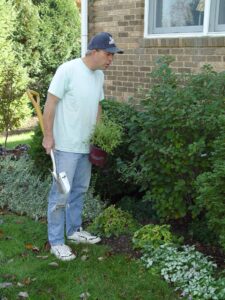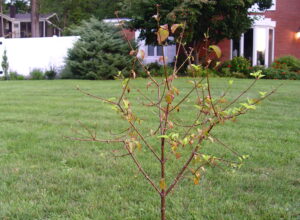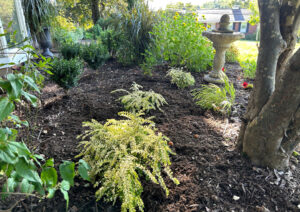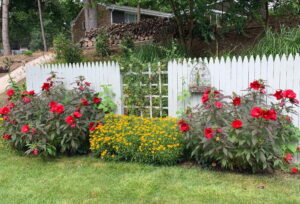Landscape Improving, Stage Three
November 5th, 2024
A landscape is never ever really “done,” as any experienced gardener will tell you.

George looking for a spot to cram in a to-be-moved plant.
However, the never-ending waltz of caring for a yard – and especially the amply landscaped variety – fits into one of three stages.
Stage one is the beginning of the line – or the end of the line, as the case may be, for the previous “landscape.” This is when you’re taking out plantings that are hopelessly overgrown, just not doing well, or outright putrid (often one that a gardener has inherited from a non-gardener).
This work can range from surgical removals, weeding, and selected whack-backs to the wholesale clearing of a bed.
Stage one can also include tackling a new garden or landscape from scratch, which usually involves getting rid of grass or a weed-infested area.
Stage two is the re-do part – the phase where novices think the project is done. In reality, it’s just the initial phase of the re-do – a time of getting your best guesses in place and then watching to see what happens.
Stage three is the longest phase and involves ongoing reaction to the changes that inevitably take place. To use a writing metaphor, it’s the editing stage.
No matter how well you or your designer knows plants and how well the phase-two planting was done, you’re going to have do at least some editing… and re-editing and re-editing.
That’s because a lot can go wrong.
Weather insults are a big one, such as the spot drought that kills water-wimpy selections or the wind storm that blows down a tree just as it was coming into prime.

Here’s what a new Cornelian cherry dogwood tree looked like the day after a deer found it.
Animal damage is another big problem, especially if deer are lurking anywhere nearby. They might eat anything when the food supply dwindles, including plants low on their preference list and ones they’ve left untouched for years.
Other times a plant that was supposed to be a winner (or is a winner in most yards) just doesn’t like your yard or the specific soil or spot you gave it.
Sometimes a bug or a disease comes along to wipe all or part of a particular planting.
Sometimes a plant gets bigger (or smaller) than you thought.
Sometimes the conditions for which you plant-selected change, such as when a nearby tree grows enough to create expanded shade or when a big tree comes down to turn shade into sudden sun.
These are the kinds of things that continue to happen over time, causing gardeners to have to rethink beds or areas of them. In other words, stage three is an ongoing phase of “spot re-do’s.”
This is the stage that drives non-gardeners (and non-gardening spouses) crazy.
“Isn’t this garden ever going to be done!?!?” they ask.
For the rabid gardener, though, stage three is the best phase.
It’s a time of fine-tuning, of being creative, of making the garden better and better as the failures and also-runs morph into successes.
Besides, what would rabid gardeners do if the landscape work were ever completely gone?
After two years of brutal labor in stage one following my move from Hampden Twp., Cumberland County, to the suburbs of Pittsburgh in 2019 and another three years of semi-brutal stage two-ing, I’ve now moved mostly into stage three.
I found myself playing a lot of “musical plants” this fall – going round and round moving this plant there and that one there until the music stopped when the growing season ended.
There was good reason for all of it, though. I thought I’d share some of what I did in case it’ll help you in your own stage-three landscaping.
One of the strategies I use in planting a new bed is trying just one or two of a plant instead of buying, say, the five or 10 of them I know I’d need to fill a planned area.
That’s a way of hedging my bet and avoiding losing 10 expensive plants that should’ve worked but died at the hand of punishing first-year weather or at the mouth of deer or groundhogs.
Too often, I’ve found, even proven plants struggle or croak in a particular new spot. Maybe it’s something peculiar to the soil or site, but sometimes I never figure out what made the plant “unhappy.”
And so I move the unhappy ones to a second-guess location and beef up the numbers of the plants that earned their keep.
An example was the ‘All Gold’ Japanese forest grass that I planted in a part-sun location to give textural and color contrast to a ‘Bartzella’ intersectional peony next to my front walk.
This sleek, arching, gold-tinted, non-deer-attractive ornamental grass seemed like a good match, but between our dry summer, ridiculous heat, competition from nearby tree and juniper roots, and apparently a little too much sun, ‘All Gold’ barely grew and looked more washed-out yellow.

Transplanted ‘Baggesen’s Gold’ box honeysuckles and an ‘All Gold’ Japanese forest gold in their new homes.
I decided to move the plant to a more shaded location in a front bed, next to a grouping of also-relocated gold-tinted ‘Baggesen’s Gold’ box honeysuckles that seemed to be getting too much sun on the poor soil of a back bank.
I filled the opening next to ‘Bartzella’ with divisions of nearby liriope, which tolerate sun and root competition a bit better. That also expanded the liriope planting to give me more of a mass – a move away from the “drifts of one” my beds too often display (thanks to constant plant-trialing).
On the back bank where the box honeysuckles departed, I moved a trial creeping St. John’s wort (Hypericum calycinum) that did well in this year’s heat and dry weather. I’ll finish off that part of the bank by buying three new sun-loving junipers.
In the same expand-the-winners vein, I noticed that my patch of three hellebores had done some seeding this past spring. So with a growing season under their belt, I dug and transplanted the toddlers to create a solid patch of eight hellebores in this dry-shade/tree-root bed.
To create space for that increased impact, I moved hostas to a full-shade part of my back bed where I’m trying to fill in between three rhododendrons (thereby avoiding future mulching). That space was previously bare.
Another plant that has done well for me in dry shade is native white wood asters. These are a bit hard to find in garden centers for some reason.
I managed to find and plant three of them three years ago, and those did so well that I found and bought three more. Those also grew well. As soon as I can find more, I’ll be expanding that flock even more.

‘American Gold Rush’ rudbeckia proved to be dividible winners in their original location between a pair of ‘Midnight Marvel’ hardy hibiscus.
What I like even better is when perennials expand fast enough on their own that I can divide and expand them for free every two years or so. Such is the case with my ‘American Gold Rush’ rudbeckia – one of the showiest, long-blooming, and solid perennials I’ve ever grown.
My original three started out looking great between a pair of ‘Midnight Marvel’ red hardy hibiscus. Two years ago, I divided off six transplants and moved them into a front garden with coreopsis, purple agastache, amsonia, mums, and some groundcover junipers.
Unfortunately, deer gnawed them off. So I salvaged the remnants and used more divisions from the original plants to create a mass of a dozen ‘American Gold Rush’ on a sunny part of the fenced-in back bank.
They did great despite a first year in the heat, sun, and poor soil of the bank… definitely a winning move, albeit on the third location in my yard.
Where the rudbeckia vacated the front-yard garden, I moved six plants of Artisan ‘Yellow Ombre’ coneflowers that had expanded from an original trial of two.
Besides moves related to performance, I’m also always on the lookout for plants that would look better next to different neighbors.
Sometimes I just overlook good pairings until a few years down the road when I suddenly ask myself, “Now why didn’t I plant that salvia in front of the white fence where it would have matched the lavender?”
Other times I’ll get a new plant (often a single trial) and be forced to find a good home for it. If there are no ideal openings, I’ll move out a marginal performer, sending it to a supposed improved spot while clearing space for the better choice of the newbie.
I hope that gives you an idea of the method behind the apparent madness. It’s not just a case of being addicted to shovels.
I don’t find the plant-moving part of gardening to be taxing or frustrating at all but rather creative and pleasantly challenging.
Moves give me the chance to improve the soil (again), and besides, I’ve found that most plants actually do better when they’re transplanted to a preferred location and in better soil to boot.
If you haven’t had that kind of success, check out the post I wrote on how to avoid transplant shock.







